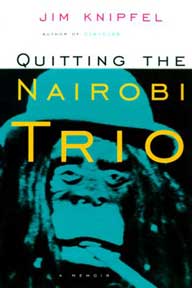Quitting the Nairobi Trio
Tarcher/Putnam, 1999
"A New York Times "Notable Book of the Year"
PLOT:
Knipfel’s second memoir concerns a drunken, suicidal, misanthropic graduate student who spends six months in a Minneapolis locked-door psych ward after an overdose, and finds none of the other patients are charming, clever, beautiful, funny, or unexpectedly wise.
Backstory:
Okay, so I admit I cheated a little here. I intentionally left this story out of Slackjaw even in th at ridiculously long first draft in the hopes I might be allowed to write another book. The events of Nairobi all take place within the space of a paragra
When my kidneys shut down following an overdose of pills and cheap scotch in 1987. one of two things happened. Either I had a complex and rambling three-day hallucination, or I died and went to hell. When I came back around, the events of what I’d experienced remained so detailed and vivid in my memory that once I was released from the bin (we weren’t allowed pen and paper in there without supervision) I wrote it all down. My intention was never publication of any kind—at the time I was still aiming toward becoming, lord help me, a philosophy professor—I merely wanted to preserve the memory, considering it a very formative event, As I wrote, I also began to piece together from clues in the hallucination exactly what was happening to me externally along the way.
I kept that story with me, and ten years later when I was given the go ahead to write a second memoir, I began with that recollection as a core and built from it to tell the whole tedious story of my stay in the ward. It was strange, really,and this was my first experience of this, but as I wrote closed and buried parts of the brain began opening up again, and I recalled details (like the closet full of straitjackets) I’d completely forgotten about. Again things came very quickly, and I wrapped this one up in about ten days.
Unfortunately (and I’m not blaming anyone, it’s just the way these things happen) the book was released at the same time as Girl, Interrupted (which so far as I can tell is about a psych ward for witty super-models) and Dave Eggers’ A heartbreaking Work of Staggering Genius. Yes, well.
One funny little sidenote. the cover art, featuring a still of one of Ernie Kovacs’ famed Nairobi Trio, was designed by Chip Kidd, who would design three of my covers. It was about a week before the books—already printed and boxed and set to ship—were scheduled for release. That’s when the art director and Kidd realized they’d never obtained the rights to use the copyrighted image. This was mighty bad news and led to a bit of frantic foofarilla, culminating in a phone call to Kovacs’ widow, the singer and comedian Edie Adams. Well, first she wanted to see the sections of the book in which Kovacs was mentioned. That was no sweat, as I never insulted him or nothing. Satisfied with that, she asked the art director, “How much do people usually get for things like this?”
“Oh, usually around $250 or $300,” he said.
She thought about this for a moment, then responded, “Okay, I’ll take $350.”
The soundtrack here was provided by a collection of music used by Ernie Kovacs, specifically Robert Maxwell’s “Solfeggio,” also known as “The Nairobi Trio Theme.”
Copyright 2015
